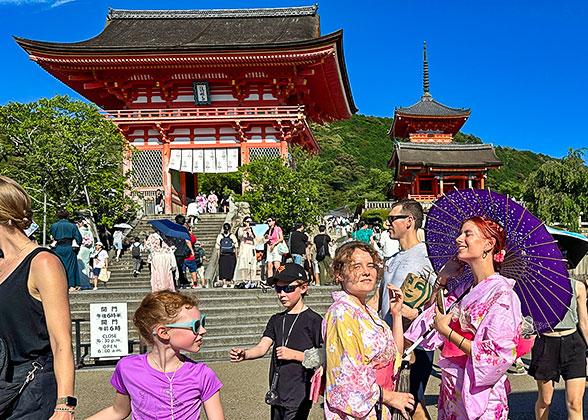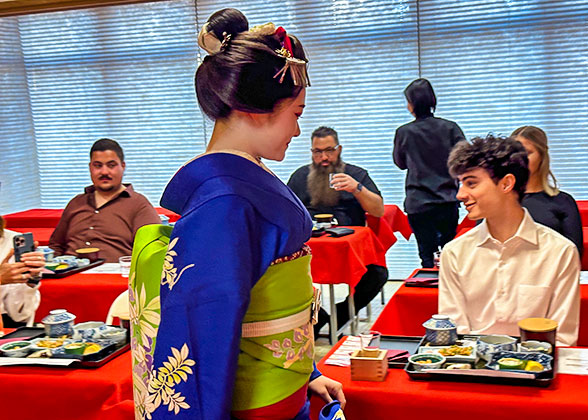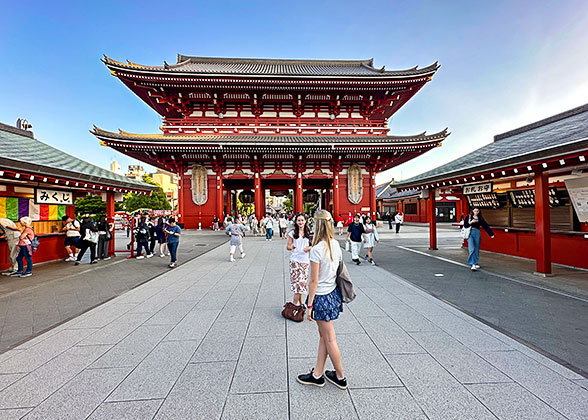Ginkaku-ji Temple
Situated in the northeast of Kyoto, Ginkaku-ji was built 540 years ago originally as the villa of Ashikaga Yoshimasa (1436-1490), a shogun who ruled Japan during the Muromachi period (1338 – 1573), and became a Zen temple after his death. The austere architecture of the temple buildings represents Higashiyama culture, which centers on Zen aesthetics and was ardently promoted by its founder. The Silver Pavilion and a raked sand garden symbolizing the vast ocean are the most important landmarks of the temple.

Ginkaku-ji Temple in Autumn
|
Ginkaku-ji is first and officially called Jisho-ji after Yoshimasa’s posthumous name, Jisho-in. The popular name only derived later from the 17th century, suggesting an association with and a contrast against Kinkaku-ji Temple, the villa of Yoshimasa’s grandfather, which is famous for its Golden Pavilion. Both temples are UNESCO-listed.
Major Attractions of Ginkaku-ji Temple
Ginkaku, the Silver Pavilion without Silver
Ginkaku, translated as Silver Pavilion, is a wooden two-story building dedicated to Kannon Bodhisattva and the symbol of the temple. Although having “silver” in its name, it was actually painted black. It’s said Yoshimasa initially planned to cover its exterior with silver leaf to echo the Golden Pavilion of his grandfather, but it was called off for lack of the government’s financial support. In fact, the silver-less structure is more pleasing to the eye, with a low-key, plain elegance, which resonates with what Zen aesthetics advocate.The first floor is called Shinku-den, literally Empty Mind Hall. It has a typical shoin-zukuri architecture, a common residential style of the Muromachi era with tatami covering all over the floor. The second floor is named Cho’on-kaku (Wave Sound Pavilion), a Zen Buddhist hall where the statue of Kannon is placed. Atop the roof is a copper phoenix.

Ginkaku, the Silver Pavilion without Silver
|
Ginshadan, the Silver Sand Garden Symbolizing Vast Ocean
To the northwest of the Silver Pavilion lies Ginshadan, one of the iconic dry landscape gardens of Japan. Visitors can find the entire courtyard carpeted with white sand, meticulously raked in highs and lows to symbolize waves from the ocean. There is also a truncated cone called Kogetsudai sitting next to the pavilion, which is said to be a mini Mount Higashiyama, holding a moon from which silver moonlight cascades at night onto the reflective sand.
|
|
|
Tongudo, Where Yoshimasa’s Spiritual World Is Housed
The Tongudo hall sits across the sand garden from the Silver Pavilion. There is a room dedicated to tea ceremony, the essence of Japanese Zen art and culture, exhibiting the spiritual world of Yoshimasa. Visitors can also go behind the hall to check out the water source the shogun used for tea.
|
|
|
Know Before Going
Opening hours:Mar 1 – November 30: 8:30 am – 5:00 pm;
December 1 – February 28: 9:00 am – 4:30 pm
Admission fee: 500 yen
How to Get There from Kyoto Station?

Entrance of the Ginkaku-ji Temple
|
Take Kyoto City Bus No. 17/No. 5 and get off at Ginkakuji-michi Station.
By train (35 minutes or so):
Take the Karasuma Line to Imadegawa Station, transfer to bus No. 203 from the Karasuma Imadegawa Station to Ginkakuji-michi Station, and walk 7 minutes.
If you visit during springtime, you can walk Philosopher’s Path, a famous destination for cherry blossom viewing along a canal, which leads to the temple.
You May Like
-
 7 Days Japan Mini Group Tour to Tokyo - Mt. Fuji - Kyoto - Nara - Osaka from USD2155
7 Days Japan Mini Group Tour to Tokyo - Mt. Fuji - Kyoto - Nara - Osaka from USD2155 -
 8 Days Mini Group Tour: Tokyo - Hakone & Mt. Fuji - Kyoto - Nara - Osaka - Hiroshima - Osaka from USD2771
8 Days Mini Group Tour: Tokyo - Hakone & Mt. Fuji - Kyoto - Nara - Osaka - Hiroshima - Osaka from USD2771 -
 16 Days Private Tour for Japan & China Discovery: Tokyo - Mt. Fuji - Kyoto - Osaka - Shanghai... from USD4883
16 Days Private Tour for Japan & China Discovery: Tokyo - Mt. Fuji - Kyoto - Osaka - Shanghai... from USD4883


